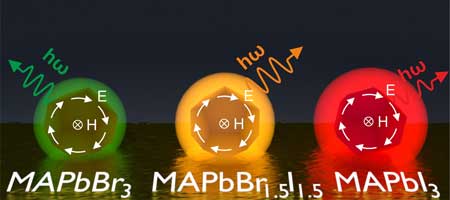| Posted: Feb 12, 2018 |
Researchers invented light-emitting nanoantennas based on halide perovskites
(Nanowerk News) Young scientists from ITMO University developed new effective nanoscale light sources based on halide perovskites. The considered nanosources are subwavelength nanoparticles, which serve both as emitters and nanoantennas and allow enhancing light emission inherently without additional devices. Moreover, perovskite enables tuning emission spectra throughout a visible range by varying the composition of the material. This makes the new nanoparticles a promising platform for creating compact optoelectronic devices such as optical chips, light-emitting diodes, or sensors. The results were published in Nano Letters ("Light-Emitting Halide Perovskite Nanoantennas").
|
 |
|
The nanoscale light sources and nanoantennas have already found a wide range of applications in several areas, such as ultra compact pixels, optical detection, or telecommunications. However, the fabrication of nanostructure-based devices is rather complicated due to the limited luminescence efficiency of the materials used typically as well as non-directional and relatively weak light emission of single quantum dots or molecules. An even more challenging task is placing a nanoscale light source precisely near a nanoantenna.
|
|
A research group from ITMO University managed to combine a nanoantenna and a light source in a single nanoparticle. It can generate, enhance and route emission via excited resonant modes coupled with excitons. "We used hybrid perovskite as a material for such nanoantennas,” says Ekaterina Tiguntseva, the first author of the publication. “Unique features of perovskite enabled us to make nanoantennas from this material. We basically synthesized perovskite films, and then transferred material particles from the film surface to another substrate by means of pulsed laser ablation technique. Compared to alternatives, our method is relatively simple and cost-effective."
|
|
While studying the obtained perovskite nanoparticles, the scientists discovered that their emission can be enhanced if its spectra match with the Mie-resonant mode. "Such resonances were named in honor of Gustav Mie, an outstanding German scientist,” explains George Zograf, Engineer at the Laboratory of Hybrid Nanophotonics and Optoelectronics at ITMO University. “He developed a general theory describing how the light interacts with sphere-like objects smaller than the wavelength. Currently, scientists are particularly interested in Mie-resonances related to dielectric and semiconductor nanoparticles. Perovskites used in our work are also semiconductors with luminescence efficiency much higher than that of many other materials. Our study shows that combination of excitons with the Mie resonance in perovskite nanoparticles makes them efficient light sources at room temperature."
|
|
In addition, the radiation spectrum of the nanoparticles can be changed by varying the anions in the composition of the material. "The structure of the material remains the same, we simply use another component in the synthesis of perovskite films. Therefore, it is not necessary to adjust the method each time. It remains the same, yet the emission color of our nanoparticles changes," says Ekaterina.
|
|
"As far as we know, no one could get subwavelength perovskite nanoantennas with an adjustable emission spectrum before,” adds George. “When we submitted this paper our senior colleagues jokingly demanded that we bake some pastry reflecting the concept of our work in case the article is accepted. As a result, we celebrated the publication of the work with cupcakes in the colors of our nanoparticles’ emission. We adopted this nice tradition from a research group led by Prof. Jeremey Baumberg at the University of Cambridge."
|
|
The scientists are currently continuing the research of light-emitting perovskite nanoantennas using various components for their synthesis. In addition, they are developing new designs of perovskite nanostructures which may improve ultra compact optical and transmission devices.
|

